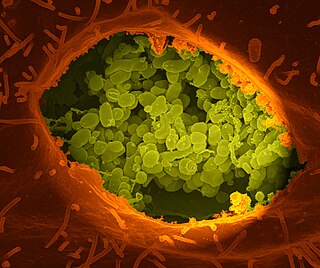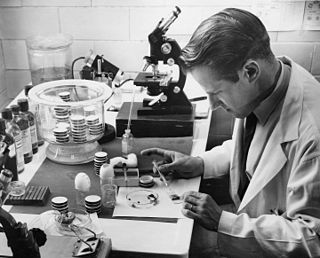
A biosafety level (BSL), or pathogen/protection level, is a set of biocontainment precautions required to isolate dangerous biological agents in an enclosed laboratory facility. The levels of containment range from the lowest biosafety level 1 (BSL-1) to the highest at level 4 (BSL-4). In the United States, the Centers for Disease Control and Prevention (CDC) have specified these levels. In the European Union, the same biosafety levels are defined in a directive. In Canada the four levels are known as Containment Levels. Facilities with these designations are also sometimes given as P1 through P4, as in the term P3 laboratory.

A biological hazard, or biohazard, is a biological substance that poses a threat to the health of living organisms, primarily humans. This could include a sample of a microorganism, virus or toxin that can adversely affect human health. A biohazard could also be a substance harmful to other living beings.

Rickettsia is a genus of nonmotile, gram-negative, nonspore-forming, highly pleomorphic bacteria that may occur in the forms of cocci, bacilli, or threads. The term "rickettsia" has nothing to do with rickets ; the bacterial genus Rickettsia instead was named after Howard Taylor Ricketts, in honor of his pioneering work on tick-borne spotted fever.

Rocky Mountain spotted fever (RMSF) is a bacterial disease spread by ticks. It typically begins with a fever and headache, which is followed a few days later with the development of a rash. The rash is generally made up of small spots of bleeding and starts on the wrists and ankles. Other symptoms may include muscle pains and vomiting. Long-term complications following recovery may include hearing loss or loss of part of an arm or leg.

Rickettsia rickettsii is a gram-negative, intracellular, coccobacillus bacterium that is around 0.8 to 2.0 μm long. R. rickettsii is the causative agent of Rocky Mountain spotted fever. R. rickettsii is one of the most pathogenic Rickettsia strains. It affects a large majority of the Western Hemisphere and small portions of the Eastern Hemisphere.
The National Institute of Allergy and Infectious Diseases is one of the 27 institutes and centers that make up the National Institutes of Health (NIH), an agency of the United States Department of Health and Human Services (HHS). NIAID's mission is to conduct basic and applied research to better understand, treat, and prevent infectious, immunologic, and allergic diseases.

Coxiella burnetii is an obligate intracellular bacterial pathogen, and is the causative agent of Q fever. The genus Coxiella is morphologically similar to Rickettsia, but with a variety of genetic and physiological differences. C. burnetii is a small Gram-negative, coccobacillary bacterium that is highly resistant to environmental stresses such as high temperature, osmotic pressure, and ultraviolet light. These characteristics are attributed to a small cell variant form of the organism that is part of a biphasic developmental cycle, including a more metabolically and replicatively active large cell variant form. It can survive standard disinfectants, and is resistant to many other environmental changes like those presented in the phagolysosome.
Tick-borne diseases, which afflict humans and other animals, are caused by infectious agents transmitted by tick bites. They are caused by infection with a variety of pathogens, including rickettsia and other types of bacteria, viruses, and protozoa. The economic impact of tick-borne diseases is considered to be substantial in humans, and tick-borne diseases are estimated to affect ~80 % of cattle worldwide.

Howard Taylor Ricketts was an American pathologist after whom the family Rickettsiaceae and the order Rickettsiales are named.

Wilhelm Burgdorfer was an American scientist born and educated in Basel, Switzerland, considered an international leader in the field of medical entomology. He discovered the bacterial pathogen that causes Lyme disease, a spirochete named Borrelia burgdorferi in his honor.
Jorge Benach is a medical researcher at the Stony Brook University in New York state. Benach is the chair of the Department of Molecular Genetics and Microbiology. Benach's main area of research is the tick-borne spirochete Borrelia burgdorferi, which is the causative agent of Lyme disease.

The Vaccine Research Center (VRC), is an intramural division of the National Institute of Allergy and Infectious Diseases (NIAID), part of the National Institutes of Health (NIH), US Department of Health and Human Services (HHS). The mission of the VRC is to discover and develop both vaccines and antibody-based products that target infectious diseases.

Yellow fever vaccine is a vaccine that protects against yellow fever. Yellow fever is a viral infection that occurs in Africa and South America. Most people begin to develop immunity within ten days of vaccination and 99 percent are protected within one month, and this appears to be lifelong. The vaccine can be used to control outbreaks of disease. It is given either by injection into a muscle or just under the skin.

Robert Allen Cooley was a US entomologist. Born in Deerfield, Massachusetts, he studied at Massachusetts Agricultural College and worked at Montana State College. He was appointed the first state entomologist for Montana in 1903, and worked on Rocky Mountain spotted fever, studying the life cycle of the tick that transmits the Rickettsia bacteria that cause the disease. He also worked on the eradication of the disease, and from 1931 until his retirement in 1946, he was head entomologist at the Rocky Mountain Laboratory, Hamilton, Montana, where the vaccine was developed. Cooley died at the age of 95 in Hamilton. The Cooley Laboratory at Montana State University is named in his honour.

Kathryn C. Zoon is a U.S.-based immunologist, elected to the U.S. Institute of Medicine in 2002 for her research on human interferons. She is the former scientific director of the Division of Intramural Research at the National Institute of Allergy and Infectious Diseases (NIAID), National Institutes of Health (NIH) in Bethesda, Maryland. From 1992 to 2002, Zoon was director of the FDA Center for Biologics Evaluation and Research (CBER).

Julie E. Ledgerwood is an American allergist and immunologist, who is the chief medical officer and serves as chief of the Clinical Trials Program at the Vaccine Research Center (VRC) of the National Institute of Allergy and Infectious Diseases (NIAID), part of the National Institutes of Health in Bethesda, Maryland. She is a Doctor of Osteopathic Medicine.

Emmie de Wit is a Dutch-American virologist. She is chief of the molecular pathogenesis unit at the Rocky Mountain Laboratories. Her research combines pathogenesis studies with detailed molecular analyses to identify molecular determinants of severe respiratory tract disease within the virus and the host.

Andrea Marzi is a German-American virologist. She is chief of the immunobiology and molecular virology unit at the Rocky Mountain Laboratories. Marzi investigates the pathogenesis of filoviruses and vaccine development. She received the Loeffler-Frosch medal in recognition of her research.

Heinz (Heinrich) Ulrich Feldmann is a German-American virologist who currently serves as the chief of the laboratory of virology at Rocky Mountain Laboratories, NIAID and heads the Disease Modelling and Transmission section. His research focuses on highly pathogenic viruses that require strict biocontainment, including those that cause viral hemorrhagic fever such as Ebola and Lassa. He has been responsible for the development of timely viral countermeasures including the rVSV-ZEBOV vaccine (Ervebro), development of vaccines and drugs against SARS-CoV-2, and epidemiology of SARS-CoV.















